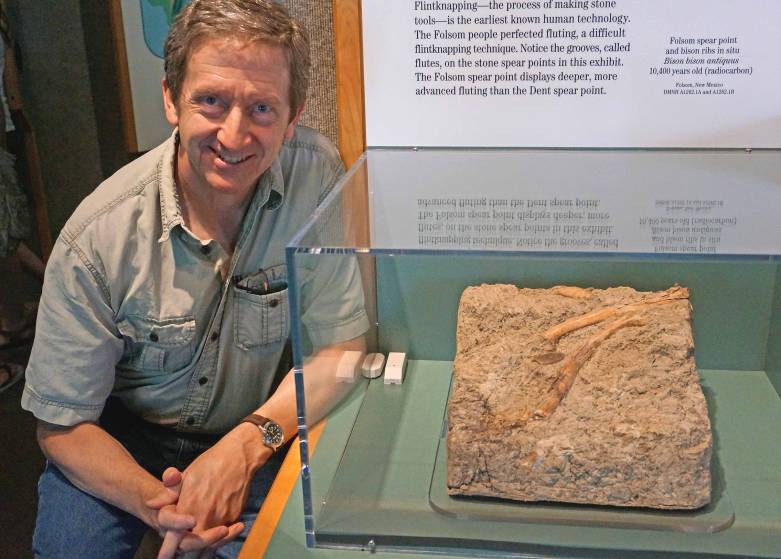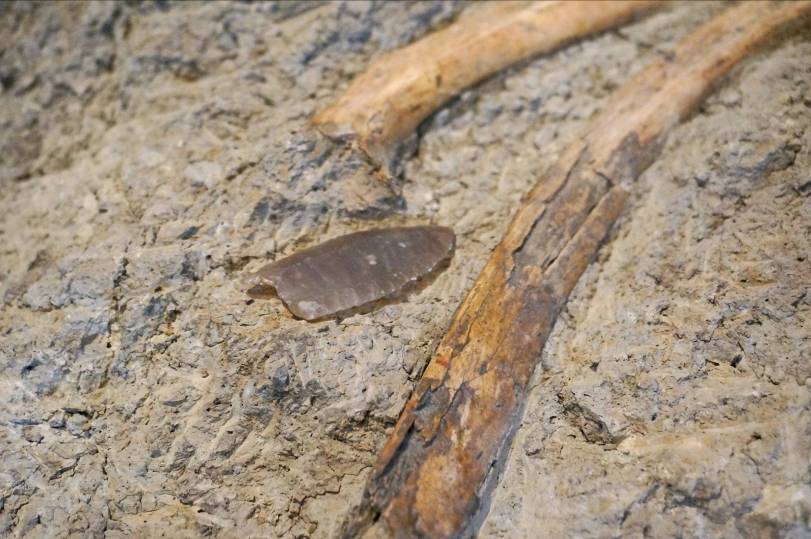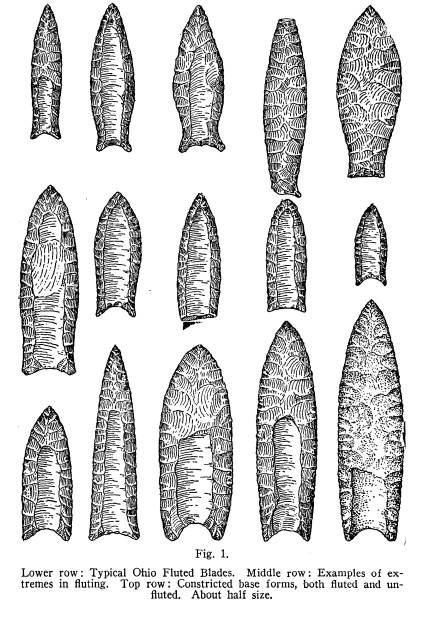 Last week I visited the Denver Museum of Nature & Science with my family. I was on a pilgrimage to see what certainly must qualify as a sacred relic of American archaeology. In spite of its significance, it was hard to find. For a while, I was afraid it might no longer be on exhibit. We finally found it tacked on to the end of the museum’s magnificent dinosaur exhibit — almost as an afterthought. At first glance it doesn’t look like much. It’s a block of reddish clay on which are arrayed a few nondescript fragments of bone and a smallish, amber-colored flint spear point. It was excavated in 1926 from the Folsom site in New Mexico. This kind of point would come to be called a Folsom point, in honor of the site where they were first found in context. And those nondescript bones belong to the long extinct species Bison antiquus.
Last week I visited the Denver Museum of Nature & Science with my family. I was on a pilgrimage to see what certainly must qualify as a sacred relic of American archaeology. In spite of its significance, it was hard to find. For a while, I was afraid it might no longer be on exhibit. We finally found it tacked on to the end of the museum’s magnificent dinosaur exhibit — almost as an afterthought. At first glance it doesn’t look like much. It’s a block of reddish clay on which are arrayed a few nondescript fragments of bone and a smallish, amber-colored flint spear point. It was excavated in 1926 from the Folsom site in New Mexico. This kind of point would come to be called a Folsom point, in honor of the site where they were first found in context. And those nondescript bones belong to the long extinct species Bison antiquus.  The Folsom discoveries represent an “historical landmark in American archeology“! Prior to 1926, most archaeologists and historians believed America’s Indians had been in this hemisphere for only a few thousand years. After Folsom, it was clear that they had arrived here at some point during the Ice Age — more than 10,000 years ago. It is no exaggeration to say that these ancient bones and the elegant stone points found in direct association led to a revolution in archaeology. America wasn’t such a new world after all. A decade after the Denver Museum’s excavations at the Folsom site, Henry C. Shetrone of the Ohio History Connection wrote an essay on the “Folsom phenomena as seen from Ohio.” It was a pioneering effort to apply the lessons learned at Folsom to the archaeological record of eastern North America. In a biographical essay on Shetrone, which was published as an introduction to a reprint of his monumental work on the Mound-Builders, I summarized the importance of Shetrone’s contribution:
The Folsom discoveries represent an “historical landmark in American archeology“! Prior to 1926, most archaeologists and historians believed America’s Indians had been in this hemisphere for only a few thousand years. After Folsom, it was clear that they had arrived here at some point during the Ice Age — more than 10,000 years ago. It is no exaggeration to say that these ancient bones and the elegant stone points found in direct association led to a revolution in archaeology. America wasn’t such a new world after all. A decade after the Denver Museum’s excavations at the Folsom site, Henry C. Shetrone of the Ohio History Connection wrote an essay on the “Folsom phenomena as seen from Ohio.” It was a pioneering effort to apply the lessons learned at Folsom to the archaeological record of eastern North America. In a biographical essay on Shetrone, which was published as an introduction to a reprint of his monumental work on the Mound-Builders, I summarized the importance of Shetrone’s contribution:

Ohio fluted points in the collection of the Ohio History Connection. From Shetrone’s essay “the Folsom phenomena as seen from Ohio.”
“This important but little known paper did three things. First, it brought about an increased awareness of the significance of these distinctive projectile points to researchers in eastern North America… Second, Shetrone documented a surprisingly large number of these points from Ohio. Clearly, Ohio, in particular and eastern North America, in general, could no longer be regarded as peripheral to this earliest chapter of America’s prehistory. Third, he presented the first distributional analysis of Paleoindian points.” The discoveries at Folsom in the mid-1920s opened a window to the deep antiquity of the peopling of the Americas. As Shetrone wrote in 1936, “However far-reaching the Folsom complex ultimately may prove to be, its immediate importance appears to attach to the question of the antiquity of man in America. In this connection, it may be recalled that, as a result of investigations covering the several decades corresponding to technical archaeological activity in America, there has come to exist a near-consensus of opinion that the peopling of the western continents is of comparatively recent occurrence; … While the attitude of this conservative group has not necessarily undergone radical revision, the significant discoveries above referred to, nevertheless, promise to thrust back the human horizon–just how far back into the past remains to be seen.”
Brad Lepper